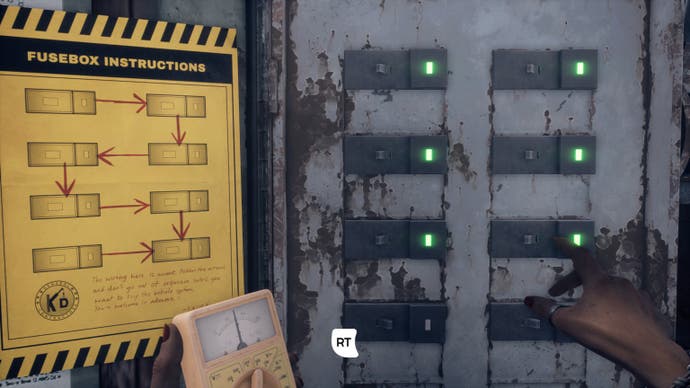Dark Pictures Anthology: The Devil In Me Review - true crime antics and dreary puzzles
Certainly devilish, occasionally delightful.
Tragedy plus time equals... mythology? Cultural fascination with true crime and serial killers is having its moment, and The Devil in Me is comfortable plucking its inspirations from the 1800s. "America's first serial killer" and serial fraudster may never have had the "murder castle" equipped with traps and torture devices that his mythology credits him with, but it's a narrative that that The Dark Pictures Anthology runs with for its escape-room slasher entry.
The Devil in Me starts at H. H. Holmes' famed "murder castle", with an utterly caricaturish Holmes as host, indulging in ominous wordplay that his guests - a pair of playful newlyweds - let fly over their heads. I fail an early heartbeat-rhythm quicktime event while sneaking around and watch the wife collapse into giggles, earning a warning from Holmes that's dripping in dramatic irony: we wouldn't want to fall and dash our skulls open, would we! And while I narrowly avoid that fate through a better-timed QTE, the two lovers are still doomed: they're prologue protagonists, after all.
The Dark Pictures Anthology episodes all follow a familiar setup, and The Devil in Me doesn't stray far from the formula. The prologue sets you up for the scares you'll be dealing with, before you meet the ensemble of characters you'll be playing with proper. Whether they live or die depends on the choices you make, whether it's a slow burn question of trust, or a split-second "run or hide".
It's slow going after the prologue, as The Devil in Me introduces its cast, a documentary crew setting out to film a modern recreation of the murder castle, built into a fog-dense island, where no phones are allowed. (Only the mildest of complaints are made about this arrangement, because nobody knows they're in a horror story, which is a conceit I continue to enjoy.)
But as I get to know more of the characters - the abrasive director, the independent grip, the shy audio technician, the insecure presenter and the conflict-avoidant cameraman - it becomes clear that I'm able to push these characters significantly less than I could in previous episodes. I have far fewer dialogue choices across far fewer conversations, and I max out - or utterly tank - character relationships within the space of a single scene.
To be transparent: One of my favourite things in horror is watching people make terrible decisions because they don't know what genre they're in, or because of their own awful flaws and impulses. There's a specific suspension of disbelief that horror indulges when people run up the stairs when a murderer shows up at their front door, and I love it for being able to make me cringe, or want to watch from behind my hands.

So when director Charlie is baited into an obvious trap because there's a carton of cigarettes in the middle of it - having been sniping at his crew all day for lack of a smoke? I love that, so it doesn't matter to me that technically in that moment there was no other way forward. But more often the way I explore a level is, both in-universe and out of it, completely unmotivated.
It doesn't feel like anyone is making a decision at all. I'm looking for a box to move around, or a switch to throw, or a gap to shimmy across, not because I need to get to the other side, but because I know finding the right part of the environment to interact with is how to progress. The Devil in Me puts much more weight on exploring, but these sequences drag, and it feels like they come at the cost of more character-driven scenes.
Not all the exploratory sequences are as slow-paced, however. In one section, I moved from room to room using only the red light from a camera sensor, and had to rush to hide every time the killer and I were about to cross paths. Even after successful QTEs I still felt tense, and every time I looked through the camera I was aware of how much of my field of vision I was voluntarily cutting off. I also appreciated in these sections how granular the accessibility settings for QTEs are, as in games where it's a binary on/off option, I usually have to opt to turn them off - which here would completely rob me of the tension.


Seeing, and watching, come up frequently in The Devil in Me. Even the way the modern-day cast is first introduced is through the lens of test footage is a reminder that someone, somewhere is watching. As they scrub forward through it, we zoom past the cast's professional experience to their candid vulnerabilities, and the visuals of them being watched unsettlingly resurface, over and over throughout the game.
We see both historic Holmes and our copycat villain as voyeurs, with old-fashioned spyholes and modern technology straddling the time jump. With our cast as true crime documentarians, the parallel feels obvious - particularly when we're treated to some delightfully sensationalist previews of the team's work. It's not subtle theming (the villain's hideout is even described as "a director's suite") but once it makes the connection it seems to stop there.
Even while characters argue about whether it's appropriate to play detective, the game wants you to play detective. The "is he mad, or does he have mother issues" speculation the crew have sounds straight out of a true crime podcast - but you can piece together biographies by picking up all the right collectibles, if you want an answer for yourself. Voyeurism: bad... unless you're achievement hunting?



Everything was in place for the conclusion to this first season to go out with a bang, with an expanded scope, a moustache-twirling villain, and a central question about our investment in true crime. It's very B-movie for its ambitions to make The Devil in Me work less well - but it's surprising that those ambitious failures make it duller, rather than messier. Mess is what The Dark Pictures does well - messy characters, messy choices, and the odd outcome that comes out of left field - and it's previously been part of the anthology's charm.
While it sometimes delivers on thrills, its bigger, better environments largely leave wide open spaces that, while beautifully rendered, expose missed opportunities. In the end, The Devil in Me is at its best when it throws anything more ambitious to the wind and goes: hey, wouldn't it be messed up if you were being chased by an axe murderer? By all means, sign me up for four more of those.




